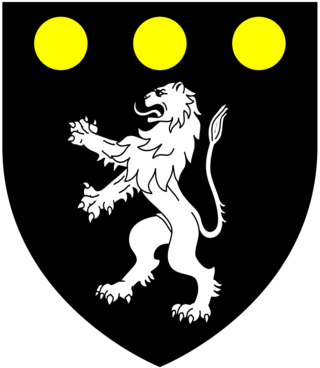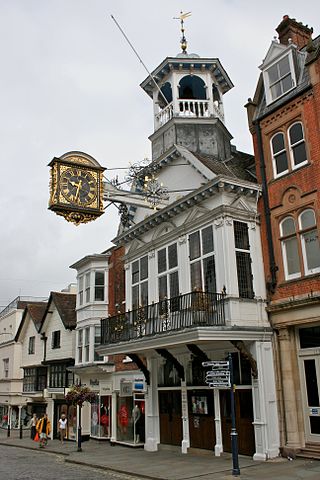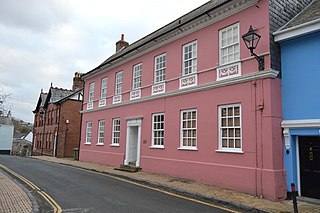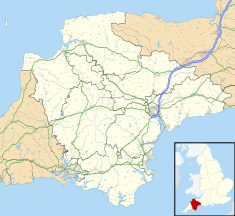
Richard Edgcumbe, 1st Baron Edgcumbe, of Mount Edgcumbe in Cornwall, was an English Whig politician who sat in the English and British House of Commons from 1701 until 1742 when he was raised to the peerage as Baron Edgcumbe. He is memorialised by Edgecombe County, North Carolina.

Plympton is a suburb of the city of Plymouth in Devon, England. It is in origin an ancient stannary town. It was an important trading centre for locally mined tin, and a seaport before the River Plym silted up and trade moved down river to Plymouth and was the seat of Plympton Priory the most significant local landholder for many centuries.

South West Devon is a constituency most recently represented in the House of Commons of the UK Parliament from 1997 to 2024, by Sir Gary Streeter, a Conservative. Plymstock Radford Councillor Rebecca Smith retained the seat for the Conservatives in the 4 July 2024 general election after Sir Gary Streeter didn't stand for re-election.
Hele's School, formerly Plympton Grammar School, is a co-educational Academy school and Sixth Form in the Plympton district of Plymouth, England, 6 miles (9.7 km) east of Plymouth city centre. Until 31 March 2011, Hele’s was a community school funded by the Local Education Authority (LEA), which is Plymouth City Council. From 1 April 2011, Hele's became an Academy, which among other things gives the school financial and educational independence. The school has a voluntary Combined Cadet Force with Navy, Army and RAF sections. Cadets in the CCF are given the option to take part in the annual Ten Tors Challenge on Dartmoor.
Plympton Erle, also spelt Plympton Earle, was a parliamentary borough in Devon. It elected two Members of Parliament (MPs) to the House of Commons from 1295 until 1832, when the borough was abolished by the Great Reform Act.

George III Treby of Plympton House, Plympton St Maurice, Devon, was a British politician.

Lieutenant-Colonel George Hele Treby was a British soldier and politician from Devonshire.

Sir George Treby JP (1643–1700), of Plympton, Devon, and of Fleet Street in the City of London, was Lord Chief Justice of the Common Pleas and six times Member of Parliament for the Rotten Borough of Plympton Erle, Devon, largely controlled by him and his descendants until abolished by the Great Reform Act of 1832.

Sir William Strode of Newnham, Plympton St Mary, Devon, was a member of the Devonshire gentry and twice served as MP for his family's pocket borough of Plympton Erle, in 1660 and 1661–1676.

The Guildford Guildhall is a Guildhall located on the High Street of the town of Guildford, Surrey. It is a Grade I listed building.

George Treby of Plympton House, Plympton St Maurice, Devon, was an English Whig politician who sat in the House of Commons for 34 years from 1708 to 1742. He was Secretary at War from 1718 to 1724, and Master of the Household from 1730 to 1741. He built Plympton House between 1715 and 1720, which his father began and left unfinished at his death in 1700.

Newnham in the parish of Plympton St Mary in Devon is a historic estate long held by the Devonshire gentry family of Strode. The ancient mansion house is situated 1 mile north-east of St Mary's Church, beside the Smallhanger Brook, a tributary of the Tory Brook, itself flowing into the River Plym. The house was abandoned by the Strode family in about 1700 when they built a new mansion on the site of Loughtor Manor House, about 1/3 mile to the north-east of Old Newnham.

Plympton House is the principal residence at the Plympton House Estate, in the parish of Plympton St Maurice, Devon, England. It is a Grade I listed country house, in the William and Mary tradition, near St Maurice's Church in Plympton, commenced by Sir George Treby (1643–1700) and completed c. 1715 – 1720 by his son George Treby. The architect is unknown although accounts in 1720 refer to William Veale, mason. Its kitchen garden wall, southern boundary walls and gate piers and walls are Grade II listed.

Montagu Edmund Parker (1737–1813) of Whiteway House, near Chudleigh and of Blagdon in the parish of Paignton, both in Devon, was Sheriff of Devon in 1789. Portraits of him by Sir Joshua Reynolds and John Downman survive at Saltram House.

Captain Paul Henry Ourry (1719–1783) was a Royal Navy officer and British politician who sat in the House of Commons from 1763 to 1775.

The Old Rectory is a grade II* listed townhouse in Plympton, Devon, England. It was listed on 23 April, 1952.

Tiverton Town Hall is a municipal building in St Andrew Street in Tiverton, Devon, England. The structure, which was the meeting place of Tiverton Borough Council, is a Grade II listed building.

Tavistock Town Hall is a municipal building in Bedford Square, Tavistock, Devon, England. The structure, which remains the main venue for civic events in the town, is a Grade II listed building.

Helston Guildhall, formerly Helston Town Hall, is a municipal building on Market Place, Helston, Cornwall, England. The structure, which is the meeting place of Helston Town Council, is a Grade II* listed building.

Church of St Maurice is located in Plympton, Devon, England. Dating to the 15th century, it is now a Grade II* listed building. The church is of Church of England denomination.



















